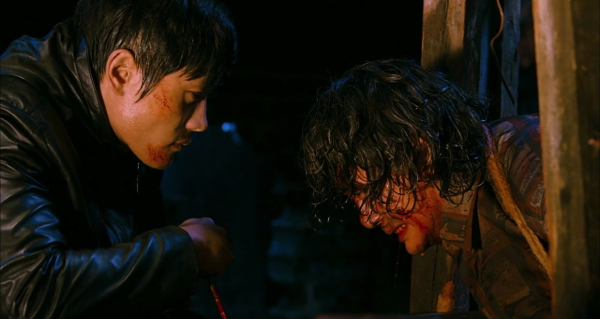Movie review by Greg Carlson
Ji-woon Kim’s “I Saw the Devil” has been likened to so-called “torture porn” titles including “Saw” and “Hostel,” but the appellation unfairly equates a thought-provoking police procedural/revenge thriller with an inferior set of mostly empty-vessel peers. Unquestionably, “I Saw the Devil” embraces explicit depictions of pain and suffering with a gruesome level of exacting detail common to the contemporary Korean horror cinema, but Kim’s genre-expanding duet between a remorseless serial killer and the government officer tracking him is strong stuff for anyone willing to gaze into twin hearts of darkness.
Min-sik Choi, whose international cult status was established by his memorable performance in “Oldboy,” plays the sadistic Kyung-chul, a nightmarish bogeyman whose “kidnap and kill” modus operandi recalls Jame “Buffalo Bill” Gumb in “The Silence of the Lambs.” When one of Kyung-chul’s victims turns out to be the daughter of a retired police chief and the fiancée of special agent Soo-hyun (Byung-hun Lee), the latter embarks on an odyssey of meticulously plotted retribution that Kim uses as a means to question the cost of payback on the one seeking satisfaction.
“I Saw the Devil” represents Kim’s most technically assured effort to date, and despite the extra weight of a 144-minute running time, the director establishes a rhythm and pace that invites the viewer to consider the purposefully outrageous, logic-defying series of choices made by the protagonist. Kim laces the film’s many physical encounters with the sinewy, visceral immediacy of close-quarters struggle (one bravura sequence is surely an homage to the elaborate in-car choreography designed by Alfonso Cuaron and Emmanuel Lubezki in “Children of Men”), and the faint of heart will recoil at the relentless close-up shots of blunt force trauma resulting in pulsating arcs of hemoglobin.
Along with phenomenal cinematographer Mo-gae Lee, Kim endeavors to bring the ugly and the beautiful into proximity, and “I Saw the Devil” is a clinic on image-making expertise. The stylized production design, particularly as evidenced in the lairs of Kyung-chul and his grim, cannibal-butcher acquaintance, showcases rainbow hues that glow with an acidic awareness of ironic discrepancy. Kim also capitalizes on his growing confidence in spatial dynamics and arresting compositions, a significant pair of assets in a movie so dependent on cat-and-mouse combat.
Despite Michael Atkinson’s accusation that Kim is both “uber-hack” and no good with nuance, what separates the filmmaker from many other practitioners of gore is Kim’s ability to humanize victims in such a way as to prevent the viewer’s purely prurient, guilt-free pleasure at the spectacle of their abject humiliation. Instead, our voyeuristic complicity stirs up a great deal of aching discomfort. Like fellow South Koreans Joon-ho Bong and Chan-wook Park, as well as Japanese mischief-maker Takashi Miike, Kim approaches genre-derived storytelling with a sense of elasticity that makes room for big stretches and leaps of the imagination. While the old concept “it takes a madman to catch a madman” has been tested countless times in noir cinema, Kim’s “I Saw the Devil” finds success in its management of startling, even risky, strategies, including a disturbing level of identification with the murderer. Once experienced, “I Saw the Devil” is hard to forget.
